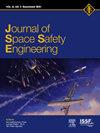Collision probability evaluation of SRM slag during orbital lifetime
IF 1.7
Q3 ENGINEERING, AEROSPACE
引用次数: 0
Abstract
At the end of combustion, a solid rocket motor (SRM) in orbit emits combustion products with relatively large particle sizes (slag). ISO 24113:2023 “Space debris mitigation requirements” defines criteria to limit debris emission 1 mm or larger in the LEO protected region. JAXA's “Space debris mitigation standard,” JMR-003E, sets out the same requirements. Hence, JAXA has begun an improvement study on SRM slag emissions as it develops the next generation of SRMs to conserve the orbital environment by significantly reducing SRM slag larger than 1 mm. However, ensuring the complete prevention of larger SRM slag emission is technically challenging. Thus, we are alternatively working to establish a risk evaluation method and criteria based on the collision probability (Pc) of SRM slag during its orbital lifetime. Based on ground firing tests, this study estimated the number and particle size of SRM slag in orbit emitted during the Epsilon and Epsilon S launch missions. The Pc per mission during the orbital lifetime was calculated and provisionally set to 10–3 for currently operational spacecraft. This paper discusses its acceptability to JAXA.
SRM炉渣轨道寿命碰撞概率评估
轨道上的固体火箭发动机(SRM)在燃烧结束时释放出颗粒较大的燃烧产物(炉渣)。ISO 24113:2023 “空间碎片缓减要求”规定了在近地轨道保护区限制碎片排放1毫米或更大的标准。JAXA的“空间碎片缓减标准”JMR-003E也提出了同样的要求。因此,JAXA在开发下一代SRM时,已经开始对SRM渣排放进行改进研究,以通过显着减少SRM渣大于1毫米来保护轨道环境。然而,确保完全防止SRM的大渣排放在技术上是具有挑战性的。因此,我们正在努力建立基于SRM炉渣轨道寿命期间碰撞概率(Pc)的风险评估方法和标准。在地面点火试验的基础上,本研究估算了Epsilon和Epsilon S发射任务中在轨发射的SRM炉渣的数量和粒度。计算了轨道寿命期间每次任务的Pc,并暂时将当前运行的航天器设置为10-3。本文讨论了它对JAXA的可接受性。
本文章由计算机程序翻译,如有差异,请以英文原文为准。
求助全文
约1分钟内获得全文
求助全文
来源期刊

Journal of Space Safety Engineering
Engineering-Safety, Risk, Reliability and Quality
CiteScore
2.50
自引率
0.00%
发文量
80
 求助内容:
求助内容: 应助结果提醒方式:
应助结果提醒方式:


